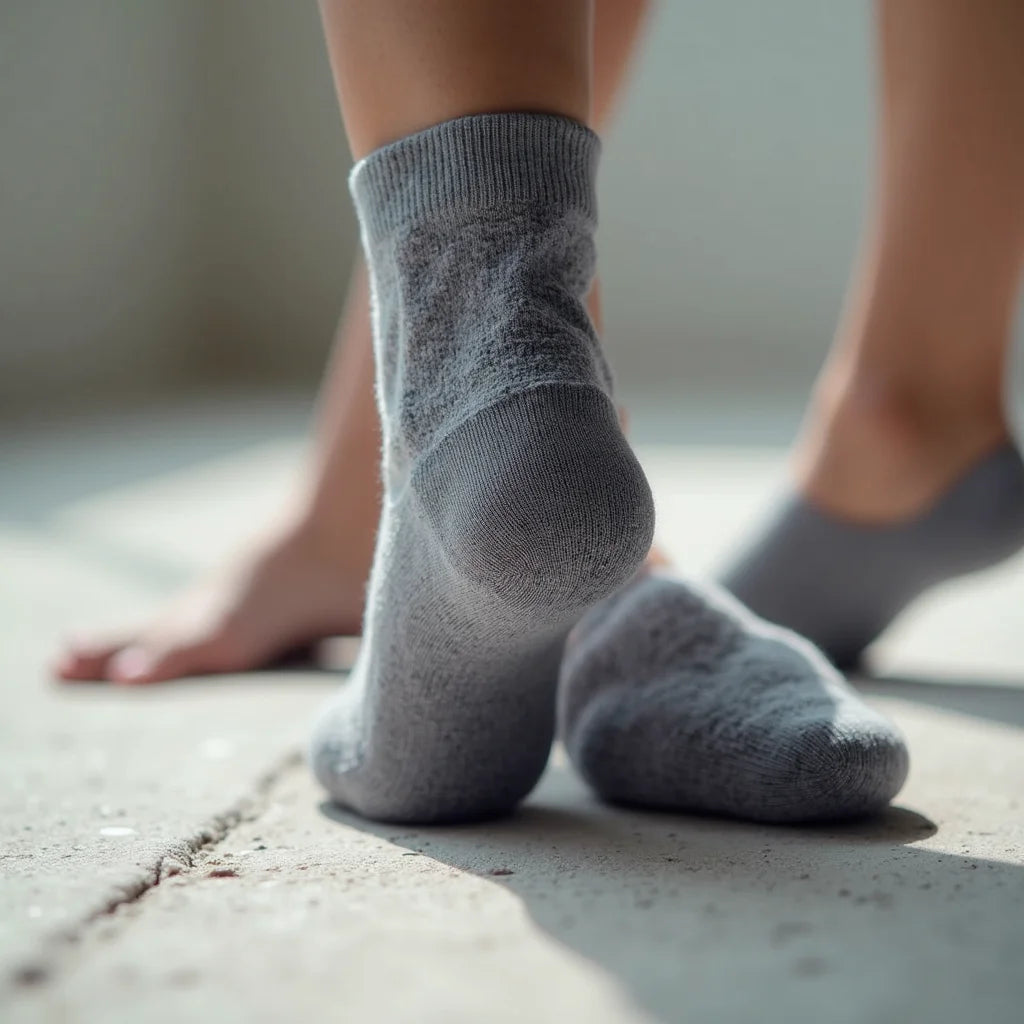Updated on: 2025-08-28
Table of Contents
- Why Pilates Grip Socks Change Your Practice
- Essential Tips for Pilates Grip Socks and Non-Slip Pilates Socks
- Grip Patterns and Materials That Matter for Pilates Sticky Socks
- Fit, Sizing, and Support: Toes and Arch Options
- Use Cases: Reformer, Mat, Barre, and Yoga
- Detailed Step-by-Step Process to Choose and Use Pilates Grip Socks
- Summary and Key Takeaway on Pilates Grip Socks
- Questions and Answers on Pilates Grip Socks
- About the Author
Pilates grip socks are small gear upgrades with big performance impact. From the first hundred words, let’s be clear: choosing the right non-slip Pilates socks and Pilates sticky socks can help you feel planted, aligned, and ready to move with focus—especially on smooth reformer platforms and polished studio floors. When your feet feel secure, you can concentrate on control, not slipping. Below, you’ll find practical tips, sizing guidance, and a proven step-by-step process that makes buying and using grip socks easy.
Essential Tips for Pilates Grip Socks and Non-Slip Pilates Socks
Use these simple, product-focused tips to find grip socks that feel great and perform workout after workout.
- Match grip coverage to the surface: For reformer work, look for full-sole silicone patterns that reach heel to toe. This keeps you steady on the carriage and footbar without bulky tread.
- Prioritize breathable, resilient yarns: Cotton blends keep feet comfortable, while a touch of elastane helps the sock retain shape and hug the arch. For hot studios, lightweight knits improve airflow.
- Choose cuff height for your workout: Ankle cuts are versatile for Pilates, barre, and yoga. If you prefer extra hold around the heel and Achilles, a slightly higher cuff can help keep socks in place.
- Arch-hugging bands add midfoot security: If you like a “held” feel, pick Pilates grip socks with toes and arch support. The extra structure can reduce sliding inside the sock.
- Consider toe style: Closed-toe designs are quick and cozy. Five-toe options allow natural toe splay, which some users find improves balance on reformers.
- Look for heel tab details: A soft heel tab helps prevent the sock from slipping down, especially during dynamic transitions.
- Keep a studio-ready rotation: Stock 3–5 pairs so you always have a dry, clean set. Rotating pairs can extend the life of sticky grips.
Grip Patterns and Materials That Matter for Pilates Sticky Socks
Pilates sticky socks rely on silicone placements that balance traction with flexibility. A dense pattern under the heel improves control in bridges and footwork, while forefoot dots support lunges and pikes on the reformer. Materials should feel soft but springy. A cotton-rich blend with elastane creates a comfortable, secure fit that moves with you as you articulate through the foot.
Fit, Sizing, and Support: Toes and Arch Options
A snug but not tight fit is essential. If your sock bunches, your footing can shift. If it’s too tight, it can distract during long holds. Toes-in or toes-out is personal preference, but if you crave natural toe spread, look for five-toe designs. For midfoot security, select models with integrated arch bands—these feel stable without adding bulk.
Use Cases: Reformer, Mat, Barre, and Yoga
On reformers, consistent traction improves confidence on the footbar and carriage. On mats, sticky soles help you hold planks and roll-ups without slipping. Barre grip socks add control on smooth floors during pliés and releveés. For cross-training, yoga grip socks offer similar traction for standing poses and flows. The shared goal is stable footing without sacrificing feel.
Ready for a dependable option that fits the above checklist? Many shoppers choose ankle-cut styles with full-sole silicone and a supportive arch band. A great example is the Antislips Grip Sock - Ankle - Beige - 3 pair pack—lightweight, secure, and easy to pair with studio wear. Explore the beige ankle grip socks multi-pack here: ankle beige grip socks.

Prefer variety? Explore color mixes and styles in curated multi-packs for easy weekly rotations: mixed 3-pair pack.
Detailed Step-by-Step Process to Choose and Use Pilates Grip Socks
- Identify your primary use. Will you train mostly on reformers, mats, or both? For reformers, choose full-sole grip coverage. For mixed barre or yoga, make sure the forefoot and heel have evenly spaced dots for directional changes.
- Pick your cuff height. Ankle cuts are versatile and low-profile. If you want extra hold at the back of the foot, choose a design with a heel tab or a slightly higher cuff for added stay-put confidence.
- Select materials for comfort. Choose a breathable cotton blend with a touch of stretch. This keeps socks soft while helping them spring back after washes.
- Decide on toe style. Closed-toe Pilates grip socks are quick, cozy, and ideal for most. If you love maximum toe articulation, five-toe grip socks can improve feel and balance.
- Check support features. Look for an arch band for midfoot hold. If you want extra contact, consider Pilates grip socks with toes and arch support for a more “locked-in” feel.
- Choose your size. Follow the brand’s size guide. If you are between sizes, opt for the snugger fit so the sock doesn’t twist during lunges, bridges, or footwork.
- Test traction at home. Before hitting the studio, try a few lunges or calf raises on a smooth floor. Your feet should feel secure and the sock should not rotate.
- Build a weekly rotation. Keep at least three pairs so one can rest while others are in use. This helps the silicone grips last longer.
- Care for longevity. Turn socks inside out before washing, use a gentle cycle, and air-dry. High heat can reduce stickiness over time.
- Expand by activity. If you also attend barre or yoga, add a pair designed for those formats. Having barre grip socks and yoga grip socks on hand keeps your routine smooth and consistent.
Want more traction tips and technique pointers? Browse a related resource for extra pointers on stability and control: Pilates socks guide.
Summary and Key Takeaway on Pilates Grip Socks
Pilates grip socks give you dependable footing so you can focus on clean lines, controlled transitions, and precise form. The best Pilates grip socks for reformer classes provide full-sole grip, breathable fabric, and a supportive arch band. If you cross-train, consider a simple rotation of non-slip Pilates socks, barre grip socks, and yoga grip socks. Select a snug fit, test traction at home, and care for your socks so the silicone stays sticky. When in doubt, start with a proven ankle-cut multi-pack and adjust from there as your training expands.
Explore a full range of colors and packs for every routine: Shop all grip socks.
Questions and Answers on Pilates Grip Socks
Do I need grip socks for Pilates, and what are the benefits?
Studios often encourage or require them for hygiene and traction. The benefits include consistent foot placement on reformers and mats, plus a more confident feel during transitions. Pilates grip socks help reduce slipping on smooth surfaces so you can focus on stability and control. Many users also like the lightweight cushion and secure, arch-hugging fit.
How do I choose the right size and material for Pilates grip socks?
Use the brand’s size guide and aim for a snug, stay-put fit. If you’re between sizes, choose the closer, not looser, option. Look for breathable cotton blends with a little stretch for shape retention. If you prefer a more structured feel, seek out Pilates grip socks with toes and arch support. Test traction at home before class to confirm the grip pattern suits your floor or reformer.
Are barre grip socks and yoga grip socks the same as Pilates grip socks?
They share the same goal—traction on smooth floors and equipment—with small differences in grip patterns and styling. For barre, forefoot and heel grip helps with rises and directional changes. For yoga, consistent grip supports standing poses and flows. Pilates often benefits from full-sole coverage for reformer work. Many people use one quality pair across all three disciplines.
How do I care for the sticky soles so they last?
Turn socks inside out before washing, use a gentle cycle, and air-dry. Avoid high heat, which can reduce stickiness. Rotate multiple pairs throughout the week and store them flat so the silicone grips aren’t compressed.
What if I want a simple, reliable set to start?
An ankle-cut multi-pack with full-sole silicone is a practical starting point. You can add five-toe or arch-support styles later. If you want a color variety right away, try a mixed 3-pair bundle for easy weekly rotation.
For a wider selection of colors, packs, and styles, browse the full catalog: View all.
About the Author
Hot Eskimo Hot Eskimo — Product specialist focused on studio-ready grip socks for Pilates, barre, and yoga. We help movers choose traction, fit, and features that match real routines, from reformer sessions to mat work. Note: This article is for general information only and is not professional advice.
The content in this blog post is intended for general information purposes only. It should not be considered as professional, medical, or legal advice. For specific guidance related to your situation, please consult a qualified professional. The store does not assume responsibility for any decisions made based on this information.

